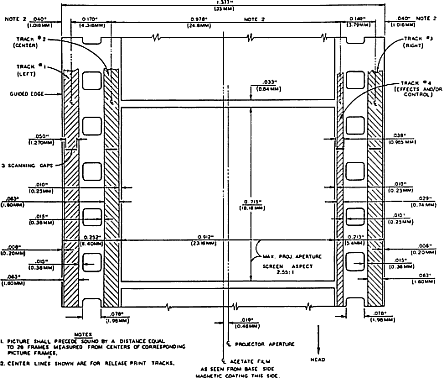to get closer to the person at the desk, we could dolly in a little. There would be no distortion nor would the camera have to go in as close - also because of using the 50mm lens. Thus, we have an example of what happens in regular picture making - less construction is necessary, an extra set-up is unnecessary, stereophonic sound has been used, and above all, a commonplace scene is fresh and new because of the different treatment. Had this same scene been done in a natural interior it can be understood why' the necessary lights could have been more readily used because less of the ceiling area is included.
![]() Naturally, one of the questions is-- "How do you make a
scene in a telephone booth." By this time, this situation
has been amply demonstrated in several films, especially
NIGHT PEOPLE, and the same logic applies as in the
foregoing example except that it is no longer necessary for
the actor to crowd in on top of the mouthpiece in order to
hold him in the picture. This leads into the question of the
"Close-up."
Naturally, one of the questions is-- "How do you make a
scene in a telephone booth." By this time, this situation
has been amply demonstrated in several films, especially
NIGHT PEOPLE, and the same logic applies as in the
foregoing example except that it is no longer necessary for
the actor to crowd in on top of the mouthpiece in order to
hold him in the picture. This leads into the question of the
"Close-up."
![]() Please let me say that the close-up is actually a relic of the
silent film. It was necessary in those days to show facial
expression, because the screen was small and there was no
dialogue to convey what the scene was about. The close-up
was carried over into sound films and is still useful for
dramatic effects. In CinemaScope pictures it is still used,
however, because of the vastness of the theatre screen, the
huge "Chokers" are no longer necessary. In fact, the figure
size of the "two-shot" is larger on the modern screen than
was the "Big Head" on the old smaller screen. I personally
prefer to use the "Over-shoulder" shot when close-ups are
required. This is possible about ninety per cent. of the time
and it certainly lends itself to far more interesting composition
plus effective use of Stereophonic sound. With CinemaScope
films there is still freedom of expression and selectivity--no
rigid rules exist. It has been my experience that when the
Director rehearses a sequence, allowing the actors to make
Please let me say that the close-up is actually a relic of the
silent film. It was necessary in those days to show facial
expression, because the screen was small and there was no
dialogue to convey what the scene was about. The close-up
was carried over into sound films and is still useful for
dramatic effects. In CinemaScope pictures it is still used,
however, because of the vastness of the theatre screen, the
huge "Chokers" are no longer necessary. In fact, the figure
size of the "two-shot" is larger on the modern screen than
was the "Big Head" on the old smaller screen. I personally
prefer to use the "Over-shoulder" shot when close-ups are
required. This is possible about ninety per cent. of the time
and it certainly lends itself to far more interesting composition
plus effective use of Stereophonic sound. With CinemaScope
films there is still freedom of expression and selectivity--no
rigid rules exist. It has been my experience that when the
Director rehearses a sequence, allowing the actors to make
